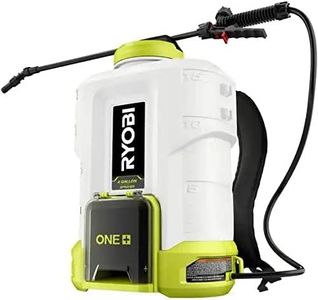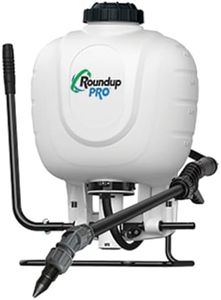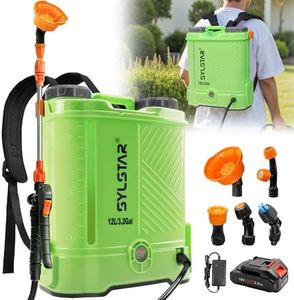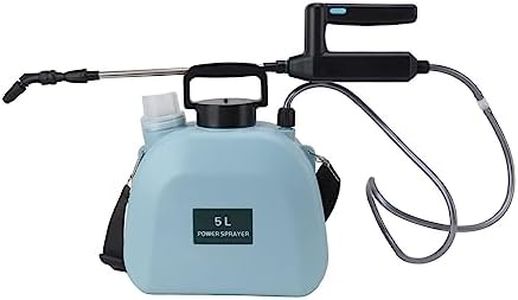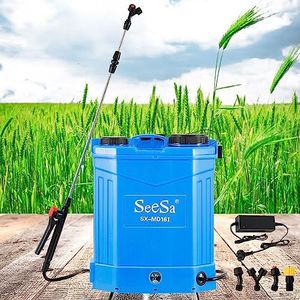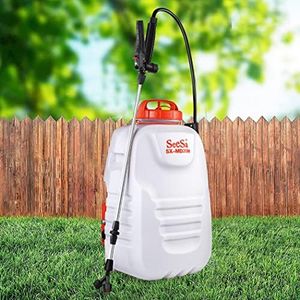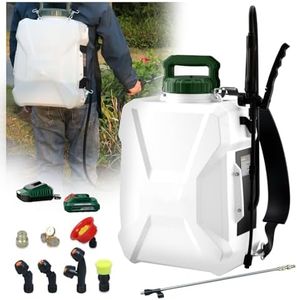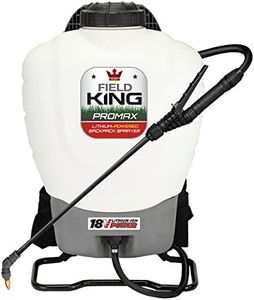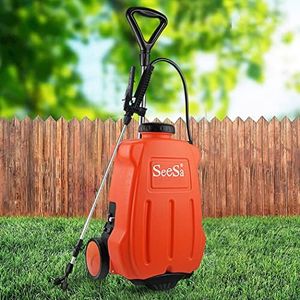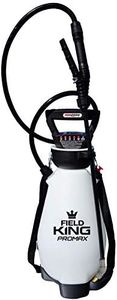We Use CookiesWe use cookies to enhance the security, performance,
functionality and for analytical and promotional activities. By continuing to browse this site you
are agreeing to our privacy policy
10 Best Electric Backpack Sprayers
From leading brands and best sellers available on the web.Buying Guide for the Best Electric Backpack Sprayers
Choosing an electric backpack sprayer is all about matching your gardening, landscaping, or agricultural needs with the right features for comfort and efficiency. Electric backpack sprayers make spraying fertilizers, pesticides, or herbicides much easier and less tiring than manual options, but picking the right one means considering how you'll use it, how long you'll work, and the type of area you'll cover. Focusing on key specs ensures you get a sprayer that's neither overkill nor underpowered for your situation.Tank CapacityTank capacity refers to how much liquid the sprayer can hold at one time. This is important because a larger tank will let you spray for longer without refilling, while a smaller tank will be lighter and easier to carry. Tank capacities typically range from about 2 to 6 gallons. For small yards or gardens, a smaller capacity can be sufficient and easier on your back. For large properties or commercial use, a bigger tank will save you time but can be much heavier when full. Think about how much area you plan to spray in one go and how much weight you are comfortable carrying.
Battery LifeBattery life tells you how long the sprayer can operate on a single charge. This is crucial for uninterrupted work. Battery life can range from around 2 hours for basic models to over 6 hours for more advanced units. If your spraying tasks are quick, shorter battery life might be fine. If you need to cover large areas or work all day, look for options with longer battery life or replaceable batteries so you can swap and keep going. Match battery life to the length of your typical spraying sessions.
Pump TypeThe pump type shapes how the sprayer works and feels. Electric backpack sprayers usually come with either diaphragm or piston pumps. Diaphragm pumps handle thicker or gritty contents better and are good for more varied chemicals, while piston pumps tend to provide higher pressure and are great for clear liquids. If you plan to use the sprayer for lots of different solutions or need extra durability, a diaphragm pump may be best. If you just need strong even pressure and stick to standard liquids, a piston pump is usually sufficient.
Spray PressureSpray pressure, measured in PSI (pounds per square inch), affects how far and fine the spray reaches. Lower pressure (40-60 PSI) is gentler and suitable for small plants or minimal drift. Medium pressure (60-90 PSI) suits average use, covering most residential needs. High pressure (90+ PSI) reaches farther and penetrates denser foliage, often needed for larger or commercial applications. Consider what and where you'll be spraying: fragile plants need less pressure, while big trees or wide fields may benefit from higher PSI.
Wand and Nozzle OptionsThe wand and nozzle determine how you deliver the spray. Some wands are adjustable for reach and comfort, while nozzle types affect spray patterns from fine mist to strong jets. Interchangeable nozzles let you adapt to various jobs, such as broad spraying or spot treatments. If you have diverse needs, look for sprayers with multiple nozzle choices and a comfortable wand. For simple, repeated tasks, a fixed nozzle may be easier and more reliable.
Comfort and ErgonomicsComfort and ergonomics relate to how easily and painlessly you can carry and operate the sprayer. Features like padded straps, adjustable harnesses, and contoured backrests make a noticeable difference in fatigue, especially during long use. If you expect to spray for extended periods or have back or shoulder concerns, prioritize ergonomic designs. For short, infrequent use, basic comfort features may be enough.
Weight (Empty and Full)Weight includes the sprayer's own mass plus the liquid when filled. Empty weight shows base portability, while full weight shows what you’ll really carry. Lighter models are easier to manage but may have smaller tanks. Always consider how much you can comfortably carry when the sprayer is full for real-world usability.
